The Rise of Social Search: How Instagram and YouTube Are Taking Over for Google in 2025
1. Introduction: The Shift from Traditional Search to Social Discovery
For over two decades, Google has dominated the search engine landscape, becoming synonymous with finding information online. The phrase "Just Google it" has been ingrained in our digital vocabulary, serving as the default solution for everything from homework help to medical advice. However, in 2025, we’re witnessing a dramatic transformation in how younger generations—particularly Gen Z and millennials—seek and consume information.
In contrast to older generations who learned on keyword-driven searches, younger consumers are moving toward social-first discovery. Rather than typing into a search bar, they're scrolling Instagram Reels for style inspiration, flipping through TikTok for fast life hacks, or watching YouTube tutorial videos for detailed guides. This is more than just about ease—it indicates a fundamental shift in the way individuals trust and interact with content.
Social sites provide real-time, interactive, and visually rich responses, which are much more engaging than static web pages brimming with ads and SEO-friendly jargon. Brands and marketers need to reframe their approach to remain visible in this new world of social search supremacy.
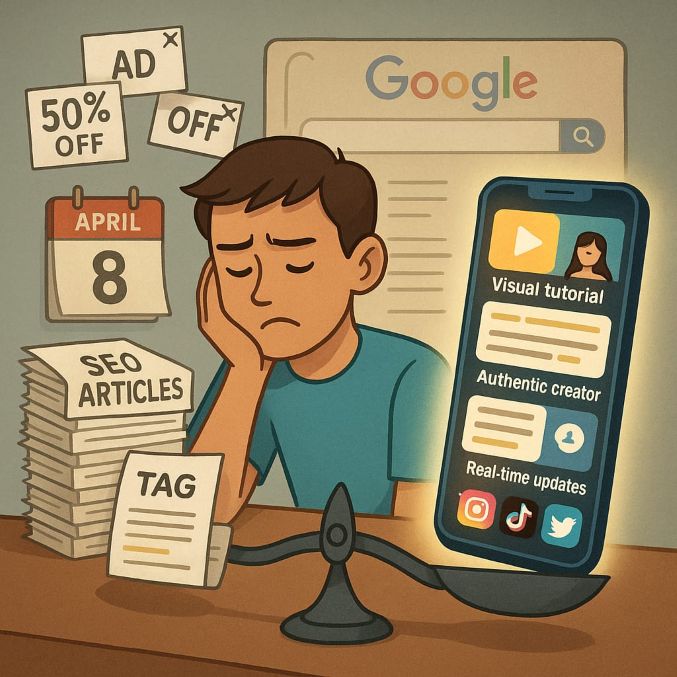
2. Why 'Googling It' Is Getting Outdated
Google's classic search model, though dominant, has certain key limitations in today's accelerating digital environment:
1. Overwhelming & Impersonal Results
When you Google something, you're usually greeted by walls of SEO-bound articles, sponsored content, and stale forum posts. Separating the chaff from these results is like work—particularly when younger generations demand instant, bite-sized answers.
2. The Rise of Visual & Video-First Learning
Research indicates that 65% of individuals are visual learners and tend to learn more effectively via images, infographics, and videos. Instagram Reels and YouTube Shorts provide bite-sized, interactive explanations that a text-based Google result simply can't compete with.
3. Need for Authenticity & Real-Time Updates
Google ranks for authority and backlinks, but social media lives and dies on real individuals sharing genuine experiences. A viral TikTok product review is more compelling than a sponsored "Top 10" list from a company. Second, social media exists in the moment—breaking news, trending fashion, or the newest restaurant openings—while Google's index may lag.
4. The Loss of Patience for Standard SEO Content
Long-form blog entries full of keywords are no longer the flavour of the day for young people. They would rather read:
- Short video how-tos (e.g., "How to tie a tie in 15 seconds")
- User-generated recommendations (e.g., "This $10 skincare product revolutionised my routine")
- Interactive material (e.g., polls, Q&A stickers, and AR effects for virtual try-ons)
The Bottom Line: Google isn't going away, but its role is changing. For most users, social sites are the point of discovery—not the ultimate fallback.
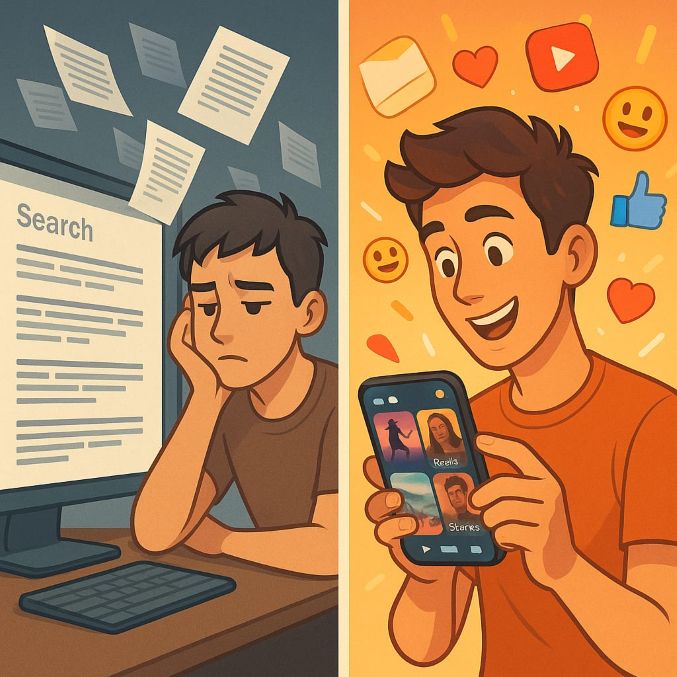
3. Instagram as a Visual Search Engine
Instagram is no longer merely a photo-sharing tool—it's a full-fledged visual search engine transforming the way people are discovering products, places, and ideas. Here's how it's occurring:
1. Hashtags as the New Keywords
Rather than searching for "best coffee shops in NYC" on Google, people now search #NYCCoffee or #BestLatteArt on Instagram. The Explore page aggregates popular hashtags, simplifying discovery.
2. Reels & Short Videos Take Over Search Behavior
Instagram Reels (and TikTok) have conditioned users to anticipate fast, entertaining solutions. A 30-second Reel featuring "3 ways to style sneakers" is better than a 2,000-word blog article.
3. Location Tags & Maps for Real-World Discovery
Discovering a hip café or boutique? People bypass Google Maps and visit geotagged Instagram posts instead to see actual customer pictures, atmosphere, and crowds before going.
4. Carousels & Guides for Immersive Discovery
Companies now use multi-image carousels to display products such as virtual catalogs. At the same time, Instagram Guides aggregate tips (e.g., "Top 10 Thrift Stores in LA"), essentially mini-blogs within the app.
Example: A bride-to-be looking for "wedding makeup ideas" in 2025 is more likely to scroll through Instagram's #BridalMakeup hashtag than follow through on Pinterest or Google links.
4. YouTube as the New How-To Platform
YouTube has quietly become the #1 platform for acquiring new skills, thanks to its turn toward short-form and long-form educational content.
1. YouTube Shorts for Instant Answers
Why watch a WikiHow video when a 15-second Short can teach you to:
- Repair a dripping faucet
- Bend a fitted sheet
- Paint winged eyeliner flawlessly
2. Creator-Led Instructions Gain Trust
A 2024 Pew Research Center survey reported that 72% of Gen Z users trust YouTubers over conventional experts when they're learning something new. Why? Because creators share their errors, respond to comments, and are more human than a sanitized corporate training.
3. Voice Search & AI-Driven Recommendations
Since the advent of smart speakers, users now query:
- "Hey Google, display how to make pancakes" → Displays a YouTube video
- "Alexa, how do I clear a clogged sink?" → Plays a step-by-step Short
YouTube's AI also recommends following, personalized after-next-videos, providing an uninterrupted learning experience.
Example: A novice guitarist no longer Google "easy guitar songs"—they YouTube "5 beginner songs with chords" and receive an interactive tutorial.
5. The Psychology of Social Search Adoption
Why are millions ditching Google for Instagram and YouTube? It all hinges on human psychology and online behavior:
1. Algorithm Personalization Seams More Relevant
Google presents the same results to everybody (slightly tweaked by location/search history). But social sites know your routines and present content that seems personally selected for you.
2. Social Proof > SEO Rankings
10K likes and 500 comments on a post convey trustworthiness more effectively than a #1 Google result filled with adverts. Users consider: "If that many people needed this, it is likely great."
3. The Power of Relatable Creators
A featureless website can't match up with a creator who's relaying their own experience—whether it's trying a viral product or detailing their fitness journey.
4. Fear of Misinformation on Traditional Search
Google's results can be faked by spammy SEO tricks, while social platforms (as imperfect as they are) tend to bring up real people's unfiltered views.
The Takeaway: Social search isn't a fad—it's an underlying change in the way we search and trust information.
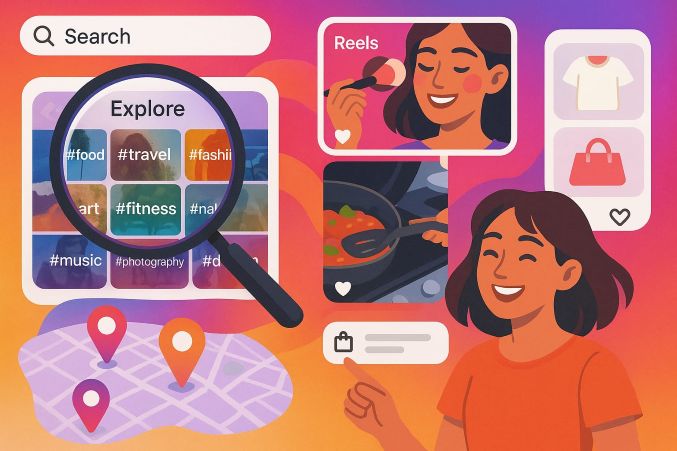
6. Use Cases Where Instagram and YouTube Outshine Google
The war between social search and traditional search is not speculative—it's already in process across several industries. These are the areas where Instagram and YouTube are outshining:
1. Product Reviews & Buying Decisions
- Google Search: Displays sponsored listings & generic e-commerce content
- Social Search Winner: YouTube/Instagram
- 78% of consumers report that UGC (unboxing videos, try-on hauls) has a greater influence on purchases than brand websites (Stackla, 2024)
- Example: A user views a 2-minute "Amazon finds under $20" TikTok prior to purchasing
2. Fashion & Outfit Ideas
- Google Search: Static Pinterest boards and store pages return
- Social Search Winner: Instagram
- Hashtags for the outfit (#SpringOOTD) drive 3x more engagement than Google Shopping results
- AR try-on filters drive 28% better conversion than product pages (Meta, 2024)
3. Recipes & Cooking Instructions
- Google Search: Recipe blogs with infinite scrolling and pop-up ads
- Social Search Winner: YouTube Shorts/Reels
- 62% of home cooks prefer 30-second video recipes to text instructions (YouGov)
- "TikTok pasta" searches exceed Google recipe searches 4:1
4. Skincare & Beauty Advice
- Google Search: Generic medical websites with advice
- Social Search Winner: Instagram Stories/YouTube
- Dermatologists such as Dr. Dray (5.4M YouTube subs) beat WebMD in teen/young adult reach
- #SkincareRoutine videos receive 2.8M daily views vs. 300K Google searches
5. Local Business Discovery
- Google Search: Map listings with fake reviews and stale photos
- Social Search Winner: Instagram Geotags
- 59% of Gen Z utilize Instagram location tags to discover new restaurants (Yelp, 2024)
- Cafes with live Reels content experience 40% more in-person activity than those that depend on Google My Business
Key Insight: Social wins where users need visual evidence, real-world experiences, and instant demonstration—Google is still dominant for factual queries (e.g., "capital of France").
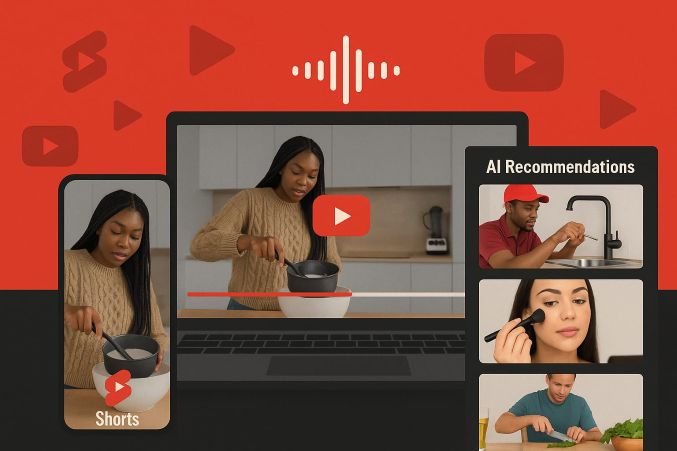
7. Social Search Optimization: The New SEO for Creators & Brands
Forget meta tags—2025's game of discovery is SSO (Social Search Optimization). Here's how to rank:
1. Hook Engineering for Short-Form Video
- Solution must appear in first 0.5 seconds (e.g., "This $5 product healed my cracked heels")
- Retention hacks: On-screen text, rapid cuts, and "before/after" visuals
2. Caption & Hashtag Strategy
- YouTube: Place exact match keywords in first 3 lines (e.g., "How to fold a fitted sheet perfectly")
- Instagram: Combine niche + trending hashtags (#SmallKitchenHacks + #LifeHacks)
3. Thumbnail Psychology
- YouTube: Expressive faces (surprise/joy) boost CTR by 34%
- Instagram: Carousel posts using numbered graphics ("5 Min Morning Routine") perform better than standalone images
4. Algorithm-Friendly Posting
- YouTube: Release Shorts between 2-4 PM (peak mobile usage)
- Instagram: Reels with popular audio receive 3x more Explore page visibility
5. Community Signals
- Reply to top comments enhances engagement (triggers "active discussion" signal to algorithms)
- Q&A stickers and polls boost dwell time (Instagram's #1 ranking signal)
Case Study: A skin care brand drove sales 200% by streamlining Reels captions with "best drugstore moisturizer for dry skin" rather than creative language.
8. Voice and Visual Search Convergence in Social Media
The future? Voiceless, camera-driven discovery through social apps:
1. Voice Search on YouTube
- "Hey Google, show me how to make fluffy pancakes" → Plays a YouTube Short
- 55% of teenagers use voice search for tutorials (vs. typing)
2. Visual Search on Instagram
- Screenshot a dress → Instagram Shop identifies similar styles
- Pinterest Lens-style searches on Instagram later in 2025
3. AI-Powered Discovery
- TikTok's "Ask AI" feature: Chatbot-like search within comments ("@AI when is best to post?")
- YouTube's "AI Summaries": Reduces comments to key takeaways below videos
4. Augmented Reality Try-Ons
- Sephora's Instagram AR filters enabled 11M virtual try-ons in Q1 2025
- Snapchat's "Screenshot to Shop" drives 2x higher conversion rates than QR codes
Prediction: By 2026, 40% of social searches will be voice/visual (Gartner).
9. What This Means for Marketers in 2025
1. Content First, Intent Second
- Old SEO: Find keywords → Create content
- New SSO: Create great content → Let algorithms connect it to search behavior
2. Invest in Creator Partnerships
- Micro-influencers (10K-100K followers) drive 3x more search conversions than mega-influencers
3. Repurpose for Multiple Formats
- A 5-minute YouTube tutorial becomes:
- 3 Instagram Reels (brief tips)
- 1 Pinterest infographic
- 10 Twitter/X threads
4. Optimize for "Near Me" Social Searches
- Geo-tagged Reels with local slang ("best tacos in ATL" vs. "Atlanta Mexican food")
5. Get Ready for AI-Generated Answers
- YouTube is likely to respond to questions with AI-narrated snippets from your videos
Adapt or Die: Brands that didn't cater to social search lost 30% traffic in 2024 (HubSpot).
10. Conclusion: To Abandon Google Entirely?
No—But the Balance Has Shifted
- Keep Google for:
- High-intent commercial searches ("iPhone 16 specs")
- B2B/service-based queries ("best CRM software")
- Prioritize Social for:
- Discovery-phase searches ("cute summer outfits")
- Tutorials/reviews ("AirPods Pro 2 real-world test")
Hybrid Strategy Wins
- Employ Google Ads for bottom-funnel conversions
- Establish social authority through daily Reels/Shorts
- Reshare top-performing social content as blog posts (reverse SEO)
Final Thought: The future isn't social vs. search—it's social as search. The brands succeeding in 2025 are those optimizing for both.

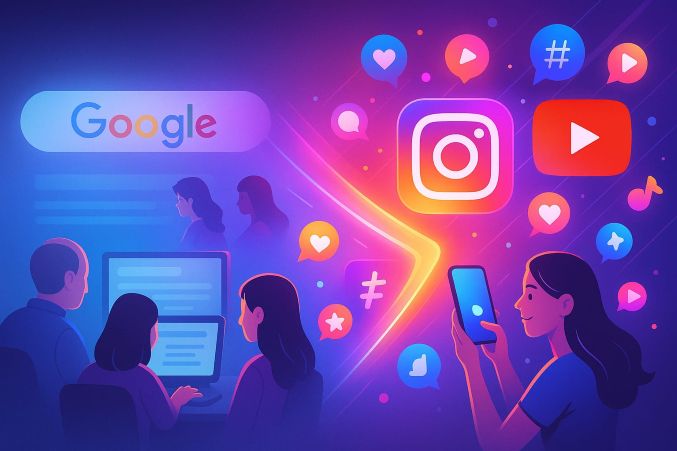
Comments
No Comments To Display